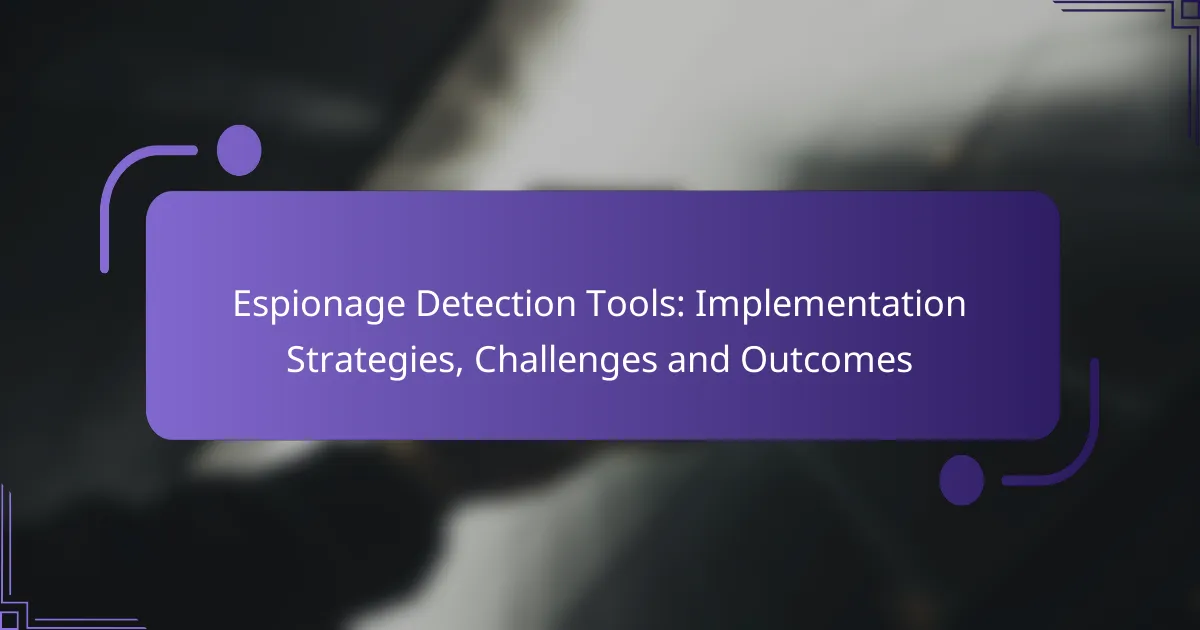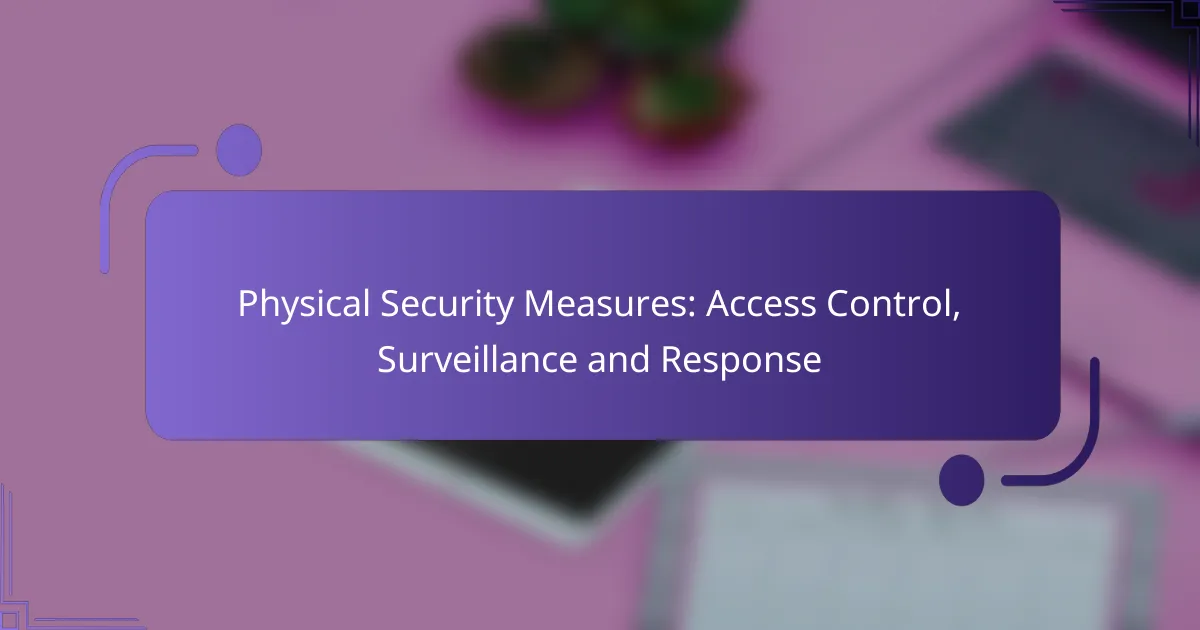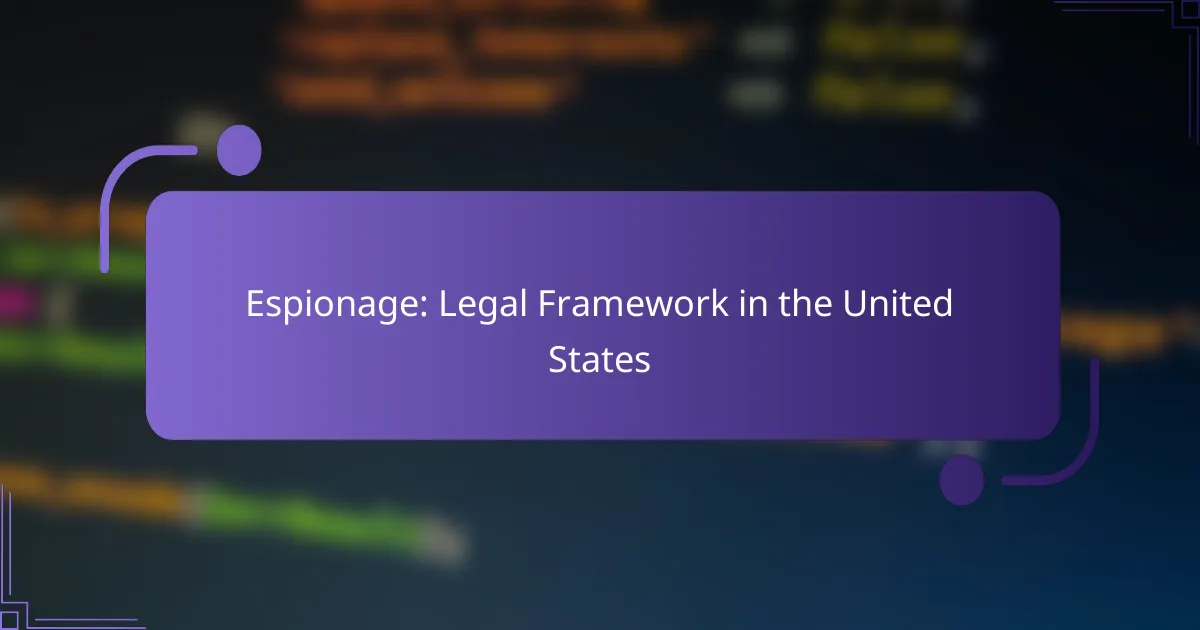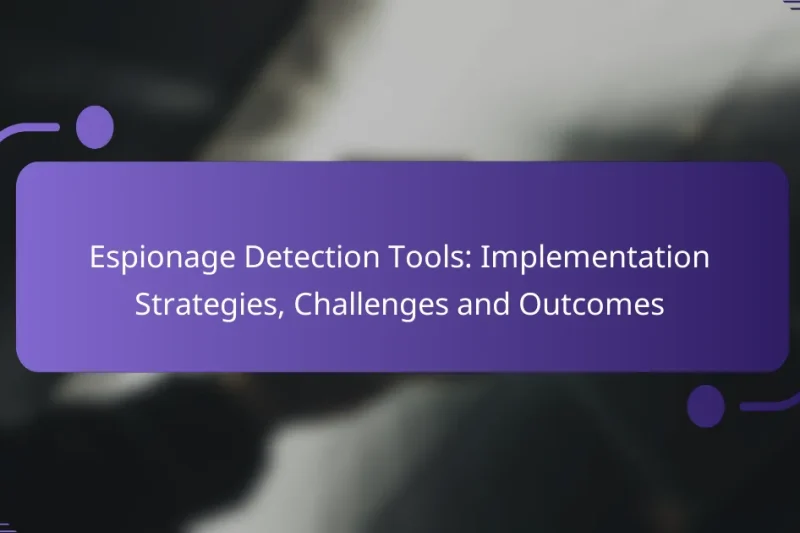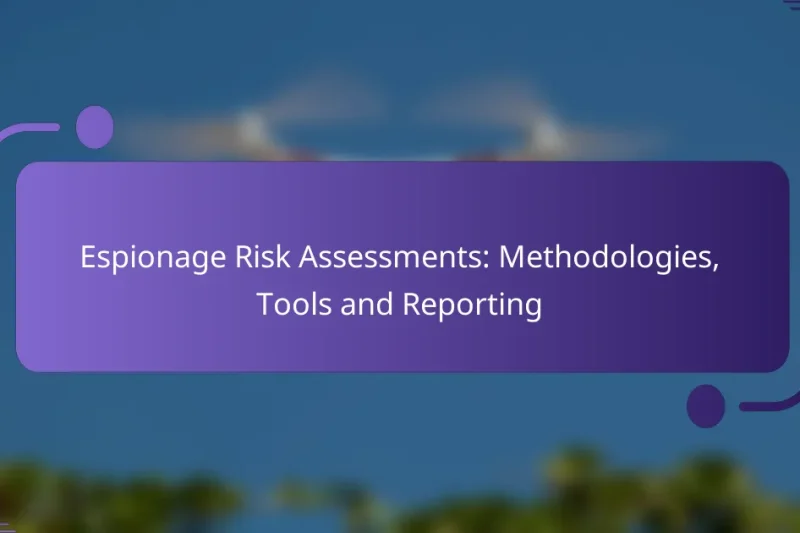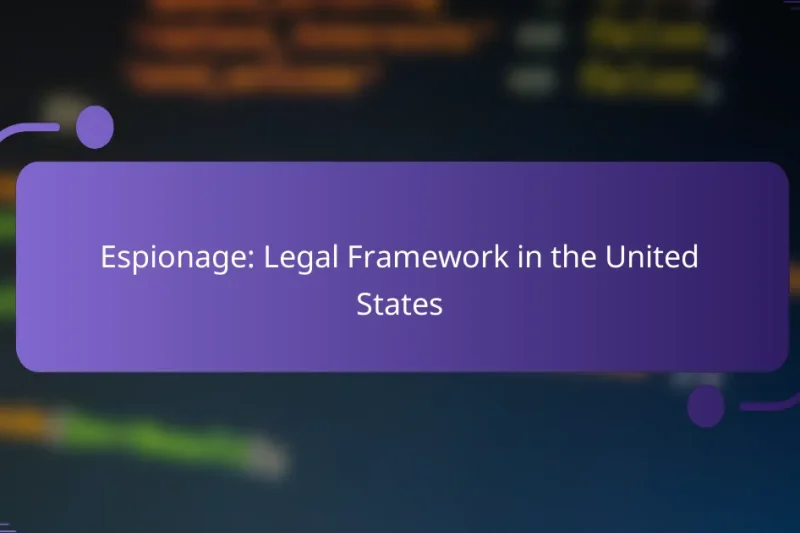Espionage detection tools are essential for safeguarding sensitive information against unauthorized surveillance and data breaches. Their … Espionage Detection Tools: Implementation Strategies, Challenges and OutcomesRead more
Espionage techniques play a crucial role in modern intelligence operations, encompassing methods such as cyber espionage, human intelligence (HUMINT), and signal intelligence (SIGINT). These techniques are systematically implemented to gather vital information, assess threats, and enhance national security while navigating complex legal landscapes. Understanding the applications and implications of these methods is essential for organizations aiming to effectively manage intelligence operations.
Espionage Risk Assessments: Methodologies, Tools and Reporting
Espionage risk assessments are crucial for organizations aiming to safeguard sensitive information from potential threats. Utilizing … Espionage Risk Assessments: Methodologies, Tools and ReportingRead more
Physical Security Measures: Access Control, Surveillance and Response
Physical security measures encompass a range of strategies, including access control, surveillance, and response protocols, aimed … Physical Security Measures: Access Control, Surveillance and ResponseRead more
Open Source Intelligence: Benefits, Tools and Best Practices for Small Businesses
Open source intelligence (OSINT) offers small businesses a cost-effective way to gather valuable insights from publicly … Open Source Intelligence: Benefits, Tools and Best Practices for Small BusinessesRead more
Espionage: Legal Framework in the United States
Espionage in the United States is defined as the act of gathering or transmitting defense information … Espionage: Legal Framework in the United StatesRead more
Cyber Espionage: Modern Business Strategies and Threat Mitigation
In today’s digital landscape, cyber espionage poses significant threats to businesses, necessitating a proactive approach to … Cyber Espionage: Modern Business Strategies and Threat MitigationRead more
Counter-Espionage Plan: Strategy, Implementation and Evaluation
Counter-espionage is a critical component of organizational security, focusing on proactive measures to identify and mitigate … Counter-Espionage Plan: Strategy, Implementation and EvaluationRead more
Human Intelligence vs. Signals Intelligence: Corporate Espionage Applications and Strategies
In the realm of corporate espionage, Human Intelligence (HUMINT) and Signals Intelligence (SIGINT) serve as two … Human Intelligence vs. Signals Intelligence: Corporate Espionage Applications and StrategiesRead more
Counter-Espionage Tools: Selection Criteria, Features and Benefits
Counter-espionage tools are crucial for safeguarding against unauthorized surveillance and spying threats, offering a range of … Counter-Espionage Tools: Selection Criteria, Features and BenefitsRead more
Espionage Techniques: Historical Case Studies and Lessons Learned
Espionage techniques have evolved significantly throughout history, encompassing methods such as human intelligence (HUMINT), signals intelligence … Espionage Techniques: Historical Case Studies and Lessons LearnedRead more
What are effective espionage techniques used in modern intelligence?
Effective espionage techniques in modern intelligence include cyber espionage, human intelligence (HUMINT), signal intelligence (SIGINT), open-source intelligence (OSINT), and technical surveillance. Each technique leverages different methods and tools to gather information, assess threats, and support national security objectives.
Cyber espionage
Cyber espionage involves infiltrating computer networks to steal sensitive information. This technique often employs malware, phishing, and social engineering to gain unauthorized access to data. Organizations must implement robust cybersecurity measures, such as firewalls and employee training, to mitigate risks.
Common targets include government agencies, corporations, and critical infrastructure. Cyber espionage can lead to significant financial losses and compromise national security, making it a high-stakes area for intelligence operations.
Human intelligence (HUMINT)
Human intelligence (HUMINT) relies on interpersonal relationships and direct interaction to gather information. This technique often involves recruiting informants or agents who can provide insights into enemy plans and activities. Successful HUMINT operations require trust-building and careful management of sources.
HUMINT can be particularly effective in environments where technical methods may fail. However, it also carries risks, including exposure of sources and potential diplomatic fallout if operations are discovered.
Signal intelligence (SIGINT)
Signal intelligence (SIGINT) focuses on intercepting and analyzing electronic communications. This includes phone calls, emails, and other forms of data transmission. SIGINT is crucial for monitoring adversaries and understanding their capabilities and intentions.
Agencies often use advanced technology to decrypt and analyze signals. However, legal and ethical considerations, such as privacy laws, must be taken into account when conducting SIGINT operations.
Open-source intelligence (OSINT)
Open-source intelligence (OSINT) involves collecting and analyzing publicly available information. This can include news articles, social media, and government reports. OSINT is valuable for gaining insights into trends and public sentiment without the need for covert operations.
While OSINT is generally low-cost and accessible, it may require significant effort to sift through vast amounts of data to find actionable intelligence. Analysts must be skilled in evaluating the credibility and relevance of sources.
Technical surveillance
Technical surveillance encompasses various methods for monitoring activities and communications using electronic devices. This can include video surveillance, wiretaps, and GPS tracking. Technical surveillance is often employed in law enforcement and intelligence operations to gather evidence or track individuals.
While effective, technical surveillance must comply with legal standards to avoid infringing on privacy rights. Agencies should ensure that they have the necessary warrants and justifications before deploying such techniques.
How do organizations implement espionage techniques?
Organizations implement espionage techniques by developing systematic approaches that include risk assessment, operational planning, and technology integration. These methods enable them to gather intelligence while minimizing exposure and legal repercussions.
Risk assessment frameworks
Effective risk assessment frameworks help organizations identify vulnerabilities and potential threats related to espionage activities. By evaluating both internal and external factors, companies can prioritize their resources and focus on the most critical areas.
Common frameworks include the NIST Cybersecurity Framework and ISO/IEC 27001, which provide guidelines for assessing risks and implementing security measures. Organizations should regularly update their risk assessments to adapt to evolving threats.
Operational planning
Operational planning involves creating detailed strategies for conducting espionage activities while ensuring compliance with legal and ethical standards. This includes defining objectives, identifying target information, and determining the resources required.
Organizations often use scenario planning to anticipate potential challenges and develop contingency plans. Clear communication and coordination among team members are essential to execute these plans effectively.
Technology integration
Integrating technology into espionage techniques enhances data collection and analysis capabilities. Tools such as surveillance software, data mining applications, and secure communication channels are commonly employed to gather intelligence efficiently.
Organizations should consider the legal implications of using specific technologies, as regulations vary by country. Regular training on technology use and updates is crucial to maintain operational effectiveness and security.
What are the legal implications of espionage techniques?
The legal implications of espionage techniques can be complex, as they often intersect with international laws and national security regulations. Engaging in espionage can lead to severe penalties, including imprisonment, depending on the jurisdiction and the specific actions taken.
International laws
International laws governing espionage primarily focus on the protection of sovereignty and human rights. Treaties such as the United Nations Charter outline principles against unlawful interference in the affairs of states. Violating these principles can lead to diplomatic tensions and sanctions.
Countries may also have bilateral agreements that define acceptable intelligence practices. For instance, espionage activities that involve cyber operations can be subject to international cyber laws, which are still evolving but increasingly recognized.
National security regulations
National security regulations vary significantly by country and dictate what constitutes permissible espionage. In the United States, the Espionage Act outlines specific offenses related to spying and the unauthorized disclosure of classified information. Violations can result in heavy fines and long prison sentences.
In many countries, laws require intelligence agencies to operate within strict guidelines to protect citizens' rights. For example, oversight committees may review operations to ensure compliance with legal standards. Understanding these regulations is crucial for anyone involved in intelligence work to avoid legal repercussions.
How can businesses protect against espionage?
Businesses can protect against espionage by implementing a multi-layered security approach that includes employee training, data encryption, and strict access control measures. These strategies help mitigate risks and safeguard sensitive information from unauthorized access.
Employee training programs
Employee training programs are essential for raising awareness about espionage threats and best practices for information security. Regular workshops and seminars can educate staff on recognizing suspicious behavior and understanding the importance of safeguarding proprietary information.
Consider incorporating role-specific training that addresses the unique risks faced by different departments. For example, finance and R&D teams may require more in-depth training on handling sensitive data compared to other departments.
Data encryption methods
Data encryption methods protect sensitive information by converting it into a format that is unreadable without the proper decryption key. Businesses should use strong encryption standards, such as AES-256, to secure data both at rest and in transit.
Implementing end-to-end encryption for communications and using secure file transfer protocols can further enhance data security. Regularly updating encryption protocols and keys is crucial to maintaining robust protection against evolving threats.
Access control measures
Access control measures limit who can view or use sensitive information within an organization. Implementing role-based access control (RBAC) ensures that employees only have access to the data necessary for their job functions, reducing the risk of unauthorized exposure.
Consider using multi-factor authentication (MFA) to add an extra layer of security for accessing critical systems. Regular audits of access permissions can help identify and rectify any unnecessary privileges that may increase vulnerability to espionage.
What role does technology play in espionage?
Technology is essential in modern espionage, enhancing the ability to gather, analyze, and disseminate intelligence. It enables operatives to conduct surveillance, intercept communications, and process vast amounts of data efficiently.
Surveillance tools
Surveillance tools are critical for monitoring individuals or groups without detection. These can include cameras, drones, and listening devices, which allow operatives to gather real-time information from a distance.
When selecting surveillance tools, consider factors such as range, resolution, and stealth capabilities. For example, high-definition cameras can capture clear images from several hundred meters away, while drones can cover large areas quickly. However, be aware of legal regulations regarding surveillance in your jurisdiction, as unauthorized monitoring can lead to severe penalties.
Data analysis software
Data analysis software is used to process and interpret the vast amounts of information collected through surveillance and other means. This software can identify patterns, trends, and anomalies that may indicate suspicious activities.
Popular tools include machine learning algorithms and data visualization platforms, which help analysts make sense of complex datasets. When choosing data analysis software, prioritize user-friendliness and compatibility with existing systems. Additionally, ensure compliance with data protection regulations to avoid legal issues while handling sensitive information.
